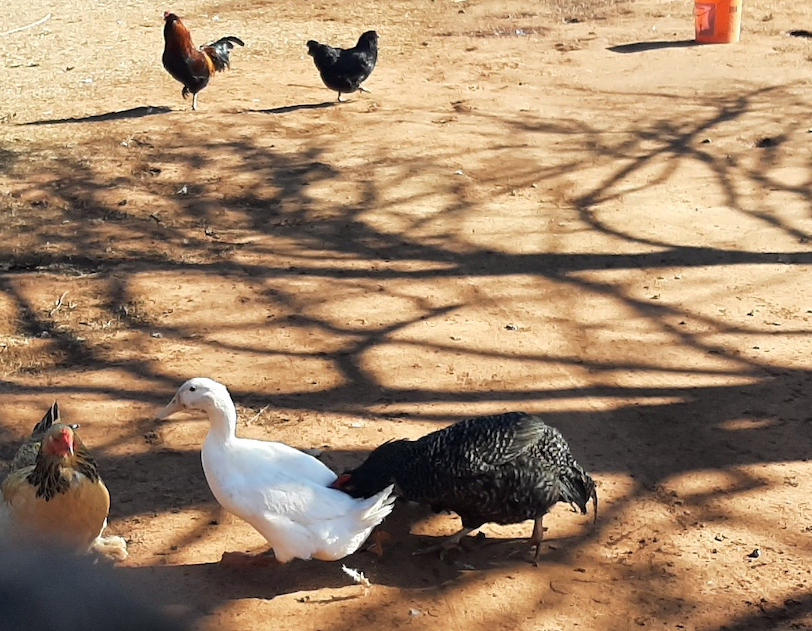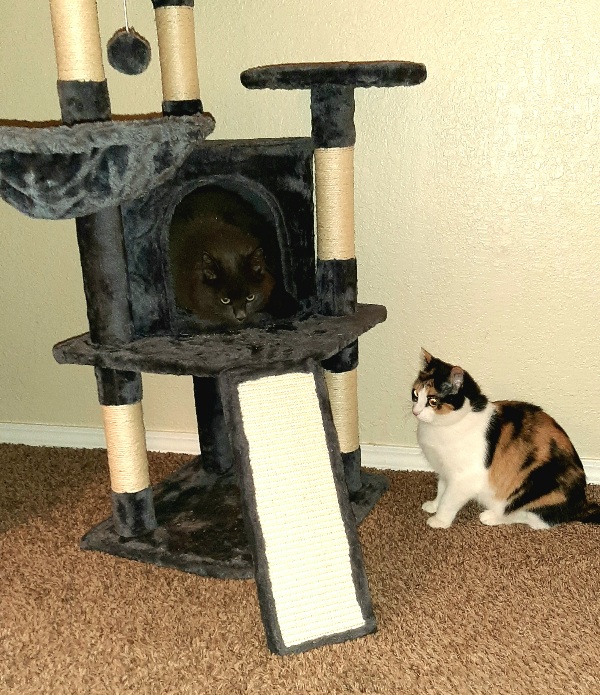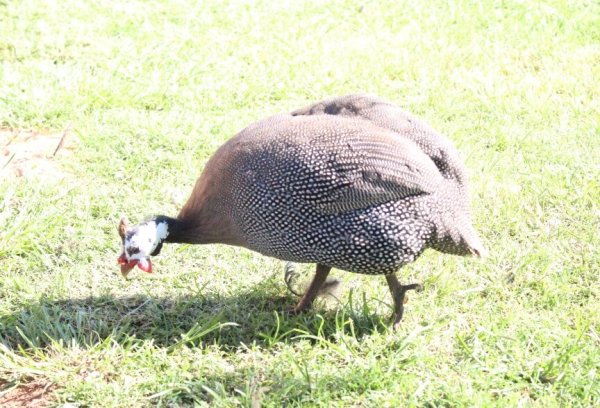I use affiliate links to support my content at no extra cost to you.
Early spring marks the start of mating season for most birds, both wild and domesticated. But how do birds find a mate? No doubt many of you are aware of courtship displays among birds. However, how, in particular, do ducks and chickens find mates? While it’s likely you know what a rooster dance is, how do ducks exhibit their desires? In addition, how do ducks and chickens recognize their mates? Moreover, how do they distinguish between male and female within their own species, and that of another?
A lot of birds, including chickens, are recognized by sex visually, as you’ll see below. However, it’s not so simple with ducks. For instance, we only have 2 kinds of ducks in our backyard: Pekin and hybrid Mallards. Hence, they all look similar by grouping in size and color. The only obvious difference are the tail feathers on the males. Rather than being straight like a female, they curve or curl upward. Well, not long ago we had an Olive Egger we named Benjamin Franklin. And he was a little odd.
Since his egg hatched the same time the guinea and duck eggs hatched, we raised him with them when he was a chick. But when he was a juvenile, we tried moving him in with the other juvenile chickens. Though, he resisted and kept going back to his original family, the ducks and guineas. However, as he got older, he’d do chicken things, like foraging and hanging out a little bit with the other juvenile roos. Though he’d always go back to his family. Eventually he started having rooster urges, like mating, but not toward any of the female chickens. He would only try to mate with the female ducks. But how did he know which of the ducks were female, and which were male? Join me as I attempt to answer these questions.
How Do Birds Find a Mate

Before a male bird performs for his intended, it’s logical for there to first be attraction. Thus, what causes roosters and hens to be attracted to each other? Likewise, what about ducks? Or, as in the case of my wayward juvenile rooster, what causes cross-species attraction?
What Attracts Roosters & Drakes to the Opposite Sex, and Vice-versa
Mainly what attracts both ducks and chickens to the opposite sex is all about the looks, such as
- color
While both sexes prefer red combs, female chickens also look for red wattles, and red eye color of potential mates. For chickens, red is a sign of health and fertility. And female ducks fancy blue plumage in a drake, which indicates reproductive strength. It’s also referred to as a special breeding plumage. Female ducks lack breeding plumage, with the exception of the Paradise Shelduck in New Zealand.
Most of our female chickens are black, black and white, or gray. Not very exciting if you ask me. However, for a short time we had one Rhode Island Red hen named Jango. She was middle-aged, and all the boys liked her. She saw more action than the rest of the hens combined. I always wondered if it was because the guys liked red-heads.
- size
Again, chickens of both sexes lean toward birds with bigger combs. However, comb length isn’t a consideration. And female ducks pick smaller drakes over larger ones.
- plumage
It seems both female ducks and chickens go with flashy plumage. For ducks, it has to be the best. Additionally, whether it’s the best ornamental feathers a rooster has or not is up to each female chicken’s interpretation, I suppose. But that’s what a hen looks for.
- social display
It’s at this point that the courtship displays come into play. And both roos and drakes have them. According to those in the know, roosters have 3 types of courtship displays: waltz, nesting, and feeding. Though, for a female chicken, the first two don’t affect her as much. Rather, if female chickens are attracted to males, it’s usually via tidbitting. Moreover, female ducks choose the most skillful performer.
- and food
Whether it’s food that males ingest themselves or offer to a potential mate, it has an effect on how well they’re received by females. In one study, female ducks preferred drakes that ate free-choice. It was probably more due to physique than the actual feed or schedule. I assume the drakes that ate free choice looked healthier. And female chickens are lured to roosters by type of treat he’s tidbitting instead of just his call. That makes sense, especially as some roos tidbit leaves or trash. The girls have priorities.
How Ducks and Chickens Recognize Mates, and Males and Females of Other Species

- Vocalization
Scientists found that chickens make around 30 sounds, 19 of which are identifiable. And both chickens and ducks can recognize members of their own species, and other signals, by vocalization. In addition, according to the University of Maryland Extension, chick embryos are able to hear around the 12th day of embryonic development. Ducklings also vocalize to each other days before hatching to synchronize their hatch day. And moms of both species communicate vocally to their young while brooding.
- Imprint at hatch
Imprinting is a quick learning method that occurs at a young age in social animals. Plus, it’s typically a result of visual and vocal cues, which lead us to the next item.
- Visual
Vision helps chicks identify and recognize their family. Though, studies claim hearing is more reliable. Additionally, chickens rely on vision for their hierarchy. But vision alone isn’t foolproof. For example, one day Chopper, one of our older ‘Cauna hens, wanted to dustbathe. But Loki, a Sex-link hen, was in the spot she wanted. Chop thought Loki was just another random black hen, because we have so many. She proceeded to bully Loki and almost got killed. Even though they were both on the same spot of the pecking order, Loki was a lot bigger. Alternatively, ducklings know their mom and siblings on sight. After all, it’s part of imprinting.
- Smell
It was initially believed that birds, including chickens, had a poor sense of smell. But studies have demonstrated chickens react to olfactory stimuli, especially in the absence of visual and auditory cues. In addition, this study revealed that chicks form behavioral associations with distinct odors that are added while they’re still in the egg. Thus, chicks can recall scents from the nest before they even hatch.
And in this experiment, it seems smell is a factor for ducks finding a mate. Even though it’s established that chickens have individual body odors and respond to familiar smells, I couldn’t find anything supporting the same in chickens. Therefore, olfaction could have an effect on mate choice with chickens, and we just don’t know it yet.
- and Pheromones
Lastly, pheromones go hand in hand with the sense of smell, especially regarding mate choice and reproduction. But since birds weren’t thought to have a sense of smell, so too they obviously couldn’t have pheromones. Although, as more and more research has shown, birds, like chickens and ducks, do have a sense of smell. It would be logical to assume then that they also release pheromones, or at the very least, their very own unique perfume.
Both ducks and chickens have a uropygial gland, aka the preen gland, which is located at the base of their tail feathers. In ducks this gland secretes a waxy fluid, which helps water-proof them. On the other hand, chickens don’t require water-proofing, but the gland still secretes an oily substance. Besides feather care, what other purpose could this serve in chickens? Additionally, it has been observed that both species emit different odors from this gland. And distinct studies on both species conclude the secretions from this gland are likely pheromones.
So, How do Birds Find a Mate

Most birds, including chickens and ducks, find mates based on color, size, and plumage. After this point, the males try to win their intended’s affection by performing a courtship display. And for some birds, like ducks, only the best performer will succeed. But don’t discount the importance of food in the bird dating game. Moreover, birds recognize each other by sound and smell often in the embryonic stage, especially if incubated together. And it’s only after hatch that they visually recognize each other.
Since my species-confused rooster was incubated and raised with guineas and ducks, it’s a possibility that he could also recognize the sounds and smells of the guineas and ducks in ova as well. And when he hatched, he could very well have imprinted on them, recognizing them as family by all of his senses. Therefore, with this insight, it also seems plausible that he would be able to distinguish between male and female. Are you wondering why Benjamin Franklin chose a duck to love instead of a guinea hen? It’s obvious to me: ducks are way smarter compared to guineas.
Have you noticed your chickens were more responsive to a particular mate, or chose one over another? Do you think there are other ways birds can recognize each other?
Thank you for stopping by! Please like, share, and if you don’t already follow me, you can do so now.
https://chickcozy.com/kristinasmith















